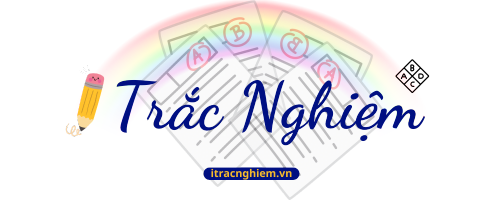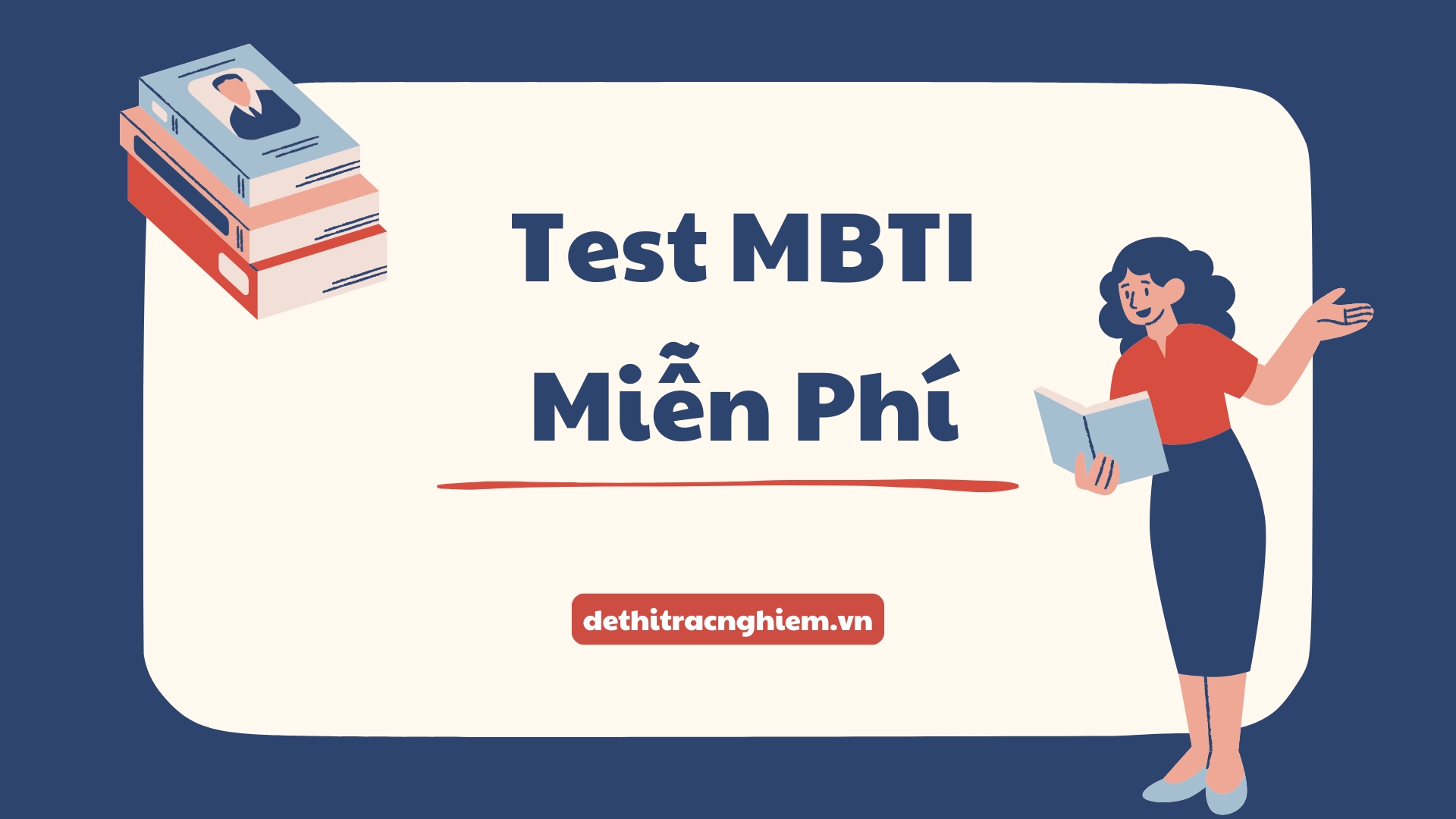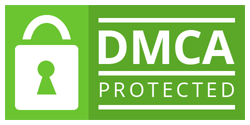Đề thi thử Đại học 2025 môn Tiếng Anh – Trường THPT Chuyên Quang Trung – Bình Phước là một trong những đề tiêu biểu thuộc Tổng hợp đề thi thử môn Tiếng Anh THPT QG, nằm trong chương trình Đề thi vào Đại học. Đây là đề thi được Trường THPT Chuyên Quang Trung (tỉnh Bình Phước) xây dựng công phu, sát với cấu trúc và định hướng của Bộ GD&ĐT cho kỳ thi tốt nghiệp THPT năm 2025.
Đề thi bao gồm đầy đủ các dạng bài quen thuộc và thiết yếu như: ngữ âm (phát âm – trọng âm), ngữ pháp và từ vựng nâng cao, chức năng giao tiếp, đọc hiểu học thuật, cloze test, và viết lại câu. Đề thi không chỉ giúp học sinh ôn luyện toàn diện kiến thức lớp 12 mà còn rèn kỹ năng đọc hiểu, phân tích ngữ cảnh và phản xạ tiếng Anh, phù hợp với xu hướng đề thi mang tính thực tiễn và phân loại cao hiện nay.
Hãy cùng Dethitracnghiem.vn khám phá ngay đề thi thử này và bắt đầu luyện tập để tự tin bước vào kỳ thi THPT Quốc gia 2025!
- Số trang: 4 trang
- Hình thức: Trắc nghiệm
- Thời gian làm bài: 50 phút (không kể thời gian phát đề)
ĐỀ THI THỬ ĐẠI HỌC MÔN TIẾNG ANH NĂM 2025 THPT CHUYÊN QUANG TRUNG – BÌNH PHƯỚC
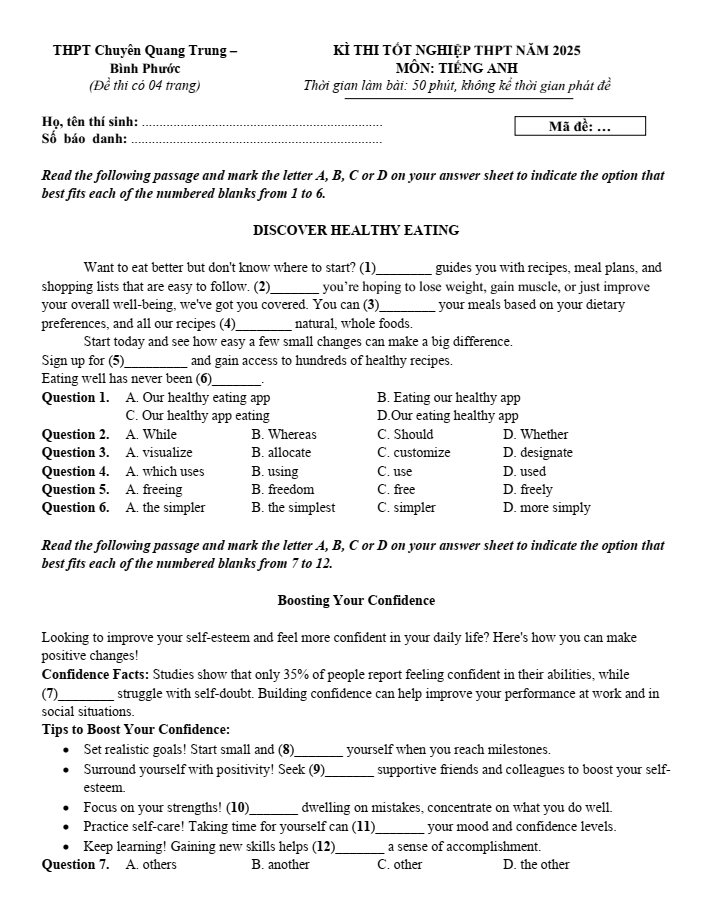
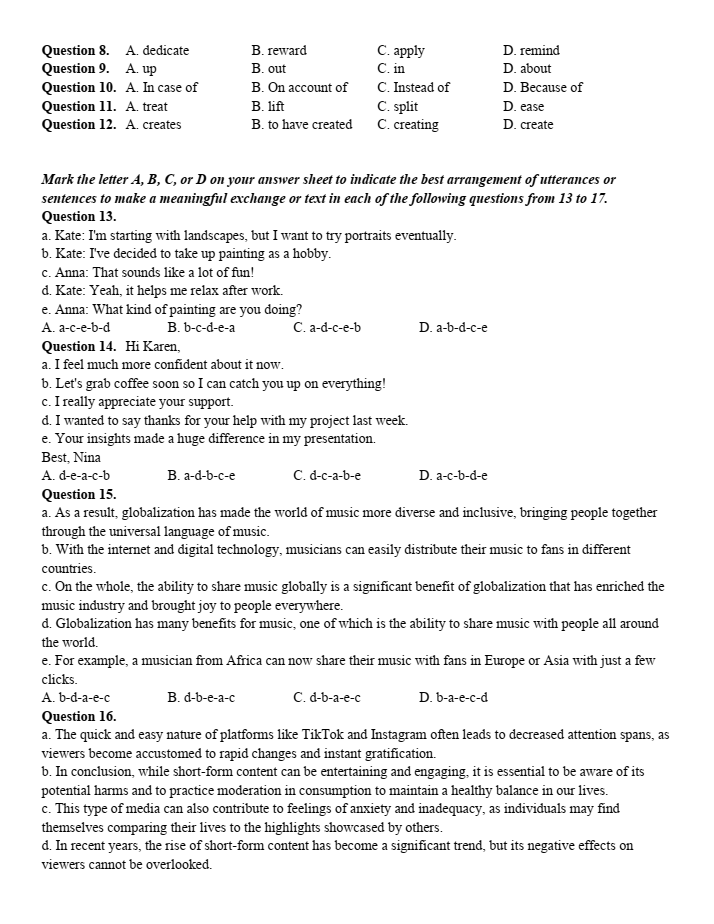
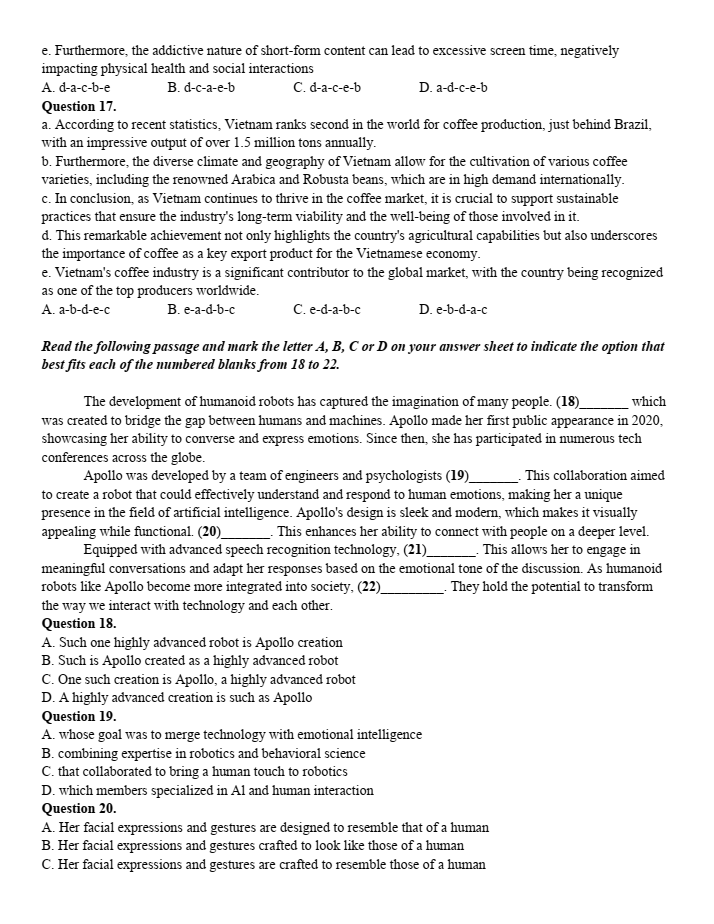
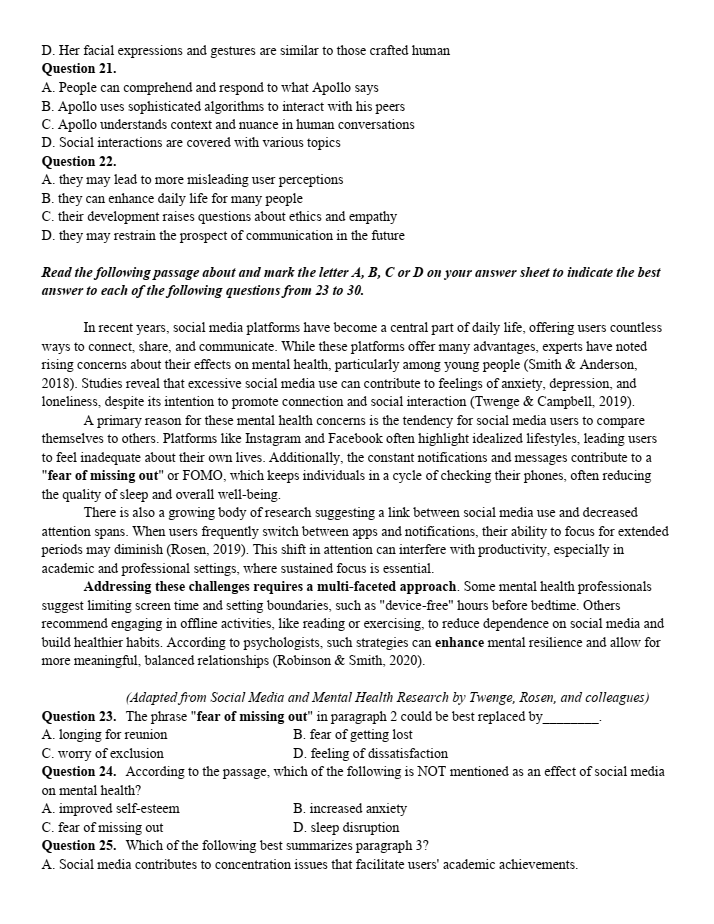
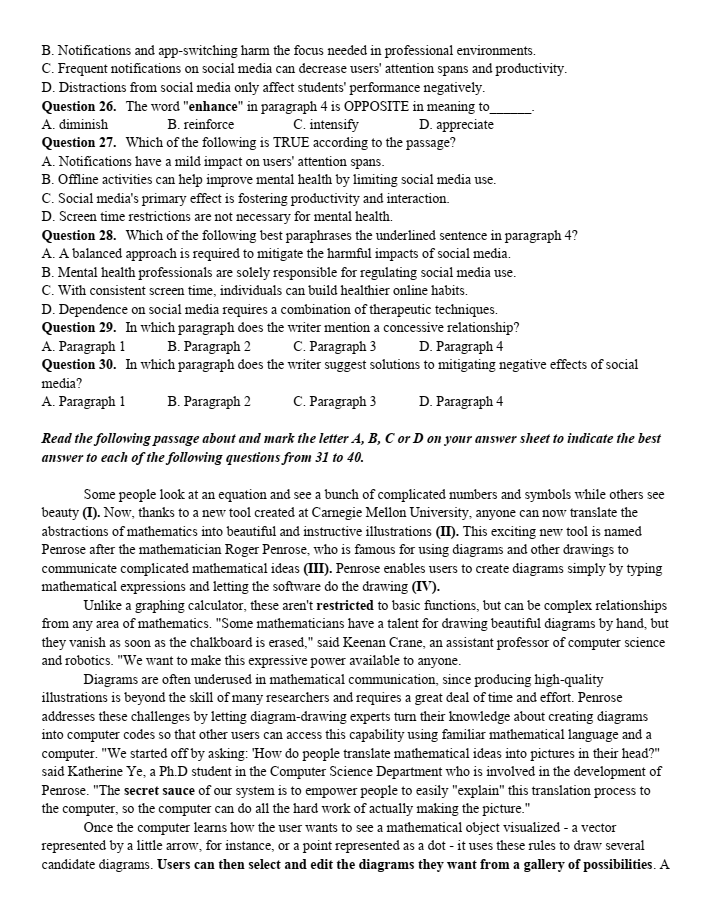

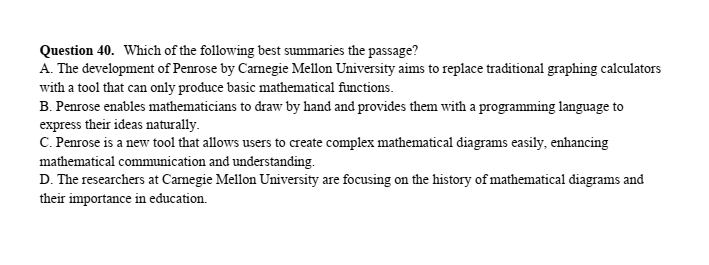
Read the following passage and mark the letter A, B, C or D on your answer sheet to indicate the option that best fits each of the numbered blanks from 1 to 6.
DISCOVER HEALTHY EATING
Want to eat better but don’t know where to start? (1)______ guides you with recipes, meal plans, and shopping lists that are easy to follow. (2)______ you’re hoping to lose weight, gain muscle, or just improve your overall well-being, we’ve got you covered. You can (3)______ your meals based on your dietary preferences, and all our recipes (4)______ natural, whole foods.
Start today and see how easy a few small changes can make a big difference.
Sign up for (5)______ and gain access to hundreds of healthy recipes.
Eating well has never been (6)______.
Question 1.
A. Our healthy eating app
B. Eating our healthy app
C. Our healthy app eating
D. Our eating healthy app
Question 2.
A. While
B. Whereas
C. Should
D. Whether
Question 3.
A. visualize
B. allocate
C. customize
D. designate
Question 4.
A. which uses
B. using
C. use
D. used
Question 5.
A. freeing
B. freedom
C. free
D. freely
Question 6.
A. the simpler
B. the simplest
C. simpler
D. more simply
Read the following passage and mark the letter A, B, C or D on your answer sheet to indicate the option that best fits each of the numbered blanks from 7 to 12.
Boosting Your Confidence
Looking to improve your self-esteem and feel more confident in your daily life? Here’s how you can make positive changes!
Confidence Facts: Studies show that only 35% of people report feeling confident in their abilities, while (7)______ struggle with self-doubt. Building confidence can help improve your performance at work and in social situations.
Tips to Boost Your Confidence:
• Set realistic goals! Start small and (8)______ yourself when you reach milestones.
• Surround yourself with positivity! Seek (9)______ supportive friends and colleagues to boost your self-esteem.
• Focus on your strengths! (10)______ dwelling on mistakes, concentrate on what you do well.
• Practice self-care! Taking time for yourself can (11)______ your mood and confidence levels.
• Keep learning! Gaining new skills helps (12)______ a sense of accomplishment.
Question 7.
A. others
B. another
C. other
D. the other
Question 8.
A. dedicate
B. reward
C. apply
D. remind
Question 9.
A. up
B. out
C. in
D. about
Question 10.
A. In case of
B. On account of
C. Instead of
D. Because of
Question 11.
A. treat
B. lift
C. split
D. ease
Question 12.
A. creates
B. to have created
C. creating
D. create
Mark the letter A, B, C, or D on your answer sheet to indicate the best arrangement of utterances or sentences to make a meaningful exchange or text in each of the following questions from 13 to 17.
Question 13.
a. Kate: I’m starting with landscapes, but I want to try portraits eventually.
b. Kate: I’ve decided to take up painting as a hobby.
c. Anna: That sounds like a lot of fun!
d. Kate: Yeah, it helps me relax after work.
e. Anna: What kind of painting are you doing?
A. a-c-e-b-d
B. b-c-d-e-a
C. a-d-c-e-b
D. a-b-d-c-e
Question 14.
Hi Karen,
a. I feel much more confident about it now.
b. Let’s grab coffee soon so I can catch you up on everything!
c. I really appreciate your support.
d. I wanted to say thanks for your help with my project last week.
e. Your insights made a huge difference in my presentation.
Best, Nina
A. d-e-a-c-b
B. a-d-b-c-e
C. d-c-a-b-e
D. a-c-b-d-e
Question 15.
a. As a result, globalization has made the world of music more diverse and inclusive, bringing people together through the universal language of music.
b. With the internet and digital technology, musicians can easily distribute their music to fans in different countries.
c. On the whole, the ability to share music globally is a significant benefit of globalization that has enriched the music industry and brought joy to people everywhere.
d. Globalization has many benefits for music, one of which is the ability to share music with people all around the world.
e. For example, a musician from Africa can now share their music with fans in Europe or Asia with just a few clicks.
A. b-d-a-e-c
B. d-b-e-a-c
C. d-b-a-e-c
D. b-a-e-c-d
Question 16.
a. The quick and easy nature of platforms like TikTok and Instagram often leads to decreased attention spans, as viewers become accustomed to rapid changes and instant gratification.
b. In conclusion, while short-form content can be entertaining and engaging, it is essential to be aware of its potential harms and to practice moderation in consumption to maintain a healthy balance in our lives.
c. This type of media can also contribute to feelings of anxiety and inadequacy, as individuals may find themselves comparing their lives to the highlights showcased by others.
d. In recent years, the rise of short-form content has become a significant trend, but its negative effects on viewers cannot be overlooked.
e. Furthermore, the addictive nature of short-form content can lead to excessive screen time, negatively impacting physical health and social interactions.
A. d-a-c-b-e
B. d-c-a-e-b
C. d-a-c-e-b
D. a-d-c-e-b
Question 17.
a. According to recent statistics, Vietnam ranks second in the world for coffee production, just behind Brazil, with an impressive output of over 1.5 million tons annually.
b. Furthermore, the diverse climate and geography of Vietnam allow for the cultivation of various coffee varieties, including the renowned Arabica and Robusta beans, which are in high demand internationally.
c. In conclusion, as Vietnam continues to thrive in the coffee market, it is crucial to support sustainable practices that ensure the industry’s long-term viability and the well-being of those involved in it.
d. This remarkable achievement not only highlights the country’s agricultural capabilities but also underscores the importance of coffee as a key export product for the Vietnamese economy.
e. Vietnam’s coffee industry is a significant contributor to the global market, with the country being recognized as one of the top producers worldwide.
A. a-b-d-e-c
B. e-a-d-b-c
C. e-d-a-b-c
D. e-b-d-a-c
Read the following passage and mark the letter A, B, C or D on your answer sheet to indicate the option that best fits each of the numbered blanks from 18 to 22.
The development of humanoid robots has captured the imagination of many people. (18)______ which was created to bridge the gap between humans and machines. Apollo made her first public appearance in 2020, showcasing her ability to converse and express emotions. Since then, she has participated in numerous tech conferences across the globe.
Apollo was developed by a team of engineers and psychologists (19)______. This collaboration aimed to create a robot that could effectively understand and respond to human emotions, making her a unique presence in the field of artificial intelligence. Apollo’s design is sleek and modern, which makes it visually appealing while functional. (20)______. This enhances her ability to connect with people on a deeper level.
Equipped with advanced speech recognition technology, (21)______. This allows her to engage in meaningful conversations and adapt her responses based on the emotional tone of the discussion. As humanoid robots like Apollo become more integrated into society, (22)______. They hold the potential to transform the way we interact with technology and each other.
Question 18.
A. Such one highly advanced robot is Apollo creation
B. Such is Apollo created as a highly advanced robot
C. One such creation is Apollo, a highly advanced robot
D. A highly advanced creation is such as Apollo
Question 19.
A. Whose goal was to merge technology with emotional intelligence
B. combining expertise in robotics and behavioral science
C. that collaborated to bring a human touch to robotics
D. whom members specialized in AI and human interaction
Question 20.
A. Her facial expressions and gestures are designed to resemble that of a human
B. Her facial expressions and gestures crafted to look like those of a human
C. Her facial expressions and gestures are crafted to resemble those of a human
D. Her facial expressions and gestures are similar to those crafted human
Question 21.
A. People can comprehend and respond to what Apollo says
B. Apollo uses sophisticated algorithms to interact with his peers
C. Apollo understands context and nuance in human conversations
D. Social interactions are covered with various topics
Question 22.
A. they may lead to more misleading user perceptions
B. they can enhance daily life for many people
C. their development raises questions about ethics and empathy
D. they may restrain the prospect of communication in the future
Read the following passage about and mark the letter A, B, C or D on your answer sheet to indicate the best answer to each of the following questions from 23 to 30.
In recent years, social media platforms have become a central part of daily life, offering users countless ways to connect, share, and communicate. While these platforms offer many advantages, experts have noted rising concerns about their effects on mental health, particularly among young people (Smith & Anderson, 2018). Studies reveal that excessive social media use can contribute to feelings of anxiety, depression, and loneliness, despite its intention to promote connection and social interaction (Twenge & Campbell, 2019).
A primary reason for these mental health concerns is the tendency for social media users to compare themselves to others. Platforms like Instagram and Facebook often highlight idealized lifestyles, leading users to feel inadequate about their own lives. Additionally, the constant notifications and messages contribute to a “fear of missing out” or FOMO, which keeps individuals in a cycle of checking their phones, often reducing the quality of sleep and overall well-being.
There is also a growing body of research suggesting a link between social media use and decreased attention spans. When users frequently switch between apps and notifications, their ability to focus for extended periods may diminish (Rosen, 2019). This shift in attention can interfere with productivity, especially in academic and professional settings, where sustained focus is essential.
Addressing these challenges requires a multi-faceted approach. Some mental health professionals suggest limiting screen time and setting boundaries, such as “device-free” hours before bedtime. Others recommend engaging in offline activities, like reading or exercising, to reduce dependence on social media and build healthier habits. According to psychologists, such strategies can **enhance** mental resilience and allow for more meaningful, balanced relationships (Robinson & Smith, 2020).
(Adapted from Social Media and Mental Health Research by Twenge, Rosen, and colleagues)
Question 23. The phrase “fear of missing out” in paragraph 2 could be best replaced by ______.
A. longing for reunion
B. fear of getting lost
C. worry of exclusion
D. feeling of dissatisfaction
Question 24. According to the passage, which of the following is NOT mentioned as an effect of social media on mental health?
A. improved self-esteem
B. increased anxiety
C. fear of missing out
D. sleep disruption
Question 25. Which of the following best summarizes paragraph 3?
A. Social media contributes to concentration issues that facilitate users’ academic achievements.
B. Notifications and app-switching harm the focus needed in professional environments.
C. Frequent notifications on social media can decrease users’ attention spans and productivity.
D. Distractions from social media only affect students’ performance negatively.
Question 26. The word “enhance” in paragraph 4 is OPPOSITE in meaning to ______.
A. diminish
B. reinforce
C. intensify
D. appreciate
Question 27. Which of the following is TRUE according to the passage?
A. Notifications have a mild impact on users’ attention spans.
B. Offline activities can help improve mental health by limiting social media use.
C. Social media’s primary effect is fostering productivity and interaction.
D. Screen time restrictions are not necessary for mental health.
Question 28. Which of the following best paraphrases the underlined sentence in paragraph 4?
A. A balanced approach is required to mitigate the harmful impacts of social media.
B. Mental health professionals are solely responsible for regulating social media use.
C. With consistent screen time, individuals can build healthier online habits.
D. Dependence on social media requires a combination of therapeutic techniques.
Question 29. In which paragraph does the writer mention ‘excessive relationship’?
A. Paragraph 1
B. Paragraph 2
C. Paragraph 3
D. Paragraph 4
Question 30. In which paragraph does the writer suggest solutions to mitigating negative effects of social media?
A. Paragraph 1
B. Paragraph 2
C. Paragraph 3
D. Paragraph 4
Read the following passage about and mark the letter A, B, C or D on your answer sheet to indicate the best answer to each of the following questions from 31 to 40.
Some people look at an equation and see a bunch of complicated numbers and symbols while others see beauty (I). Now, thanks to a new tool created at Carnegie Mellon University, anyone can now translate the abstractions of mathematics into beautiful and instructive illustrations (II). This exciting new tool is named Penrose after the mathematician Roger Penrose, who is famous for using diagrams and other drawings to communicate complicated mathematical ideas (III). Penrose enables users to create diagrams simply by typing mathematical expressions and letting the software do the drawing (IV).
Unlike a graphing calculator, these aren’t **restricted** to basic functions, but can be complex relationships from any area of mathematics. “Some mathematicians have a talent for drawing beautiful diagrams by hand, but they vanish as soon as the chalkboard is erased,” said Keenan Crane, an assistant professor of computer science and robotics. “We want to make this expressive power available to anyone.
Diagrams are often underused in mathematical communication, since producing high-quality illustrations is beyond the skill of many researchers and requires a great deal of time and effort. Penrose addresses these challenges by letting diagram-drawing experts turn their knowledge about creating diagrams into computer codes so that other users can access this capability using familiar mathematical language and a computer. “We started off by asking: ‘How do people translate mathematical ideas into pictures in their head?'” said Katherine Ye, a Ph.D student in the Computer Science Department who is involved in the development of Penrose. “The **secret sauce** of our system is to empower people to easily “explain” this translation process to the computer, so the computer can do all the hard work of actually making the picture.”
Once the computer learns how the user wants to see a mathematical object visualized – a vector represented by a little arrow, for instance, or a point represented as a dot – it uses these rules to draw several candidate diagrams. Users can then select and edit the diagrams **they** want from a gallery of possibilities. A special, simple-to-learn programming language was also developed so that they can easily convey the ideas in their minds to the Penrose system. Crane said, “Mathematicians can get very picky about notations.” He explained. “We let them define whatever notation they want, so they can express themselves naturally.”
The researchers will present Penrose at the SIGGRAPH 2020 Conference on Computer Graphics and Interactive Techniques, which will be held this July. “Our vision is to be able to dust off an old math textbook from the library, drop it into the computer and get a beautifully illustrated book – that way more people understand.” Crane said, noting that Penrose is a first step toward this goal.
(Adapted from sciencedaily.com)
Question 31. Which best serves as the title for the passage?
A. Penrose: The Tool Making All Textbooks Outdated
B. Visualizing Mathematics With Penrose
C. Why Mathematicians Cannot Draw Diagrams
D. The Age of Computer Mathematicians
Question 32. Where in paragraph 1 does the following sentence best fit?
For many, the elegance of mathematical concepts is often unarticulated amidst the complexity.
A. (I)
B. (II)
C. (III)
D. (IV)
Question 33. The word “restricted” in paragraph 2 is OPPOSITE in meaning to ______
A. contained
B. expanded
C. confined
D. discard
Question 34. The phrase “secret sauce” in paragraph 3 could be best replaced by______
A. unexpected benefit
B. mysterious figure
C. unnatural ability
D. special element
Question 35. According to the passage, which of the following is NOT mentioned as a feature of benefit of the Penrose tool?
A. It allows users to create diagrams from mathematical expressions.
B. It can produce high-quality illustrations without requiring advanced drawing skills.
C. It enables users to communicate mathematical ideas using a programming language.
D. It can automatically generate solutions to complex mathematical problems.
Question 36. The word “they” in paragraph 4 refers to______
A. users
B. diagrams
C. possibilities
D. ideas
Question 37. Which of the following best summarizes paragraph 3?
A. Penrose allows users to create high-quality diagrams quickly without needing artistic skills.
B. Diagrams in mathematics are often underused due to the time required to create them.
C. Penrose enables users to translate mathematical ideas into diagrams using expert knowledge and computer codes.
D. Katherine Ye discusses the challenges mathematicians face when trying to visualize complex ideas.
Question 38. Which of the following best paraphrases the underlined sentence in paragraph 4?
A. Users can browse and alter the diagrams they like from a variety of choices.
B. Users can create and adjust the diagrams they desire from a selection of examples.
C. Users can choose and modify the diagrams they prefer from a collection of options.
D. Users can view and customize the diagrams they wish to use from an assortment of images.
Question 39. Which of the following can be inferred from the passage?
A. Hand-drawn diagrams are not as beautiful and easy to understand as digital diagrams.
B. In general, mathematicians are not very good at remembering and defining notations.
C. How a mathematical object should be visualized varies from person to person.
D. Almost all people consider traditional math textbooks to be extremely boring.
Question 40. Which of the following best summarizes the passage?
A. The development of Penrose by Carnegie Mellon University aims to replace traditional graphing calculators with a tool that can only produce basic mathematical functions.
B. Penrose enables mathematicians to draw by hand and provides them with a programming language to express their ideas naturally.
C. Penrose is a new tool that allows users to create complex mathematical diagrams easily, enhancing mathematical communication and understanding.
D. The researchers at Carnegie Mellon University are focusing on the history of mathematical diagrams and their importance in education.
Mục đích tổ chức kỳ thi Đại học năm 2025 là gì?
Căn cứ theo quy chế hiện hành của Bộ Giáo dục và Đào tạo và các văn bản hướng dẫn tổ chức kỳ thi Đại học năm 2025, mục đích của kỳ thi là:
– Đánh giá kết quả học tập của học sinh sau 12 năm học theo yêu cầu của chương trình giáo dục phổ thông.
– Lấy kết quả thi để xét công nhận tốt nghiệp trung học phổ thông và làm căn cứ tuyển sinh đại học, cao đẳng.
– Góp phần đánh giá chất lượng giáo dục của địa phương và cả nước, làm cơ sở điều chỉnh nội dung, phương pháp dạy học trong nhà trường.
Thí sinh thi Đại học năm 2025 có bắt buộc thi môn Tiếng Anh không?
Theo quy định hiện hành của Bộ Giáo dục và Đào tạo và hướng dẫn tổ chức kỳ thi tốt nghiệp Đại học năm 2025, thí sinh dự thi phải thực hiện như sau:
– Thi 3 môn bắt buộc: Toán, Ngữ văn và Ngoại ngữ.
– Ngoài ra, thí sinh phải chọn một trong hai bài thi tổ hợp: Khoa học Tự nhiên (gồm các môn Vật lí, Hóa học, Sinh học) hoặc Khoa học Xã hội (gồm các môn Lịch sử, Địa lí, Giáo dục công dân – dành cho học sinh học chương trình giáo dục phổ thông).
Trong số các môn thi, Tiếng Anh là một trong ba môn thuộc bài thi Ngoại ngữ bắt buộc, thí sinh phải thi môn Tiếng Anh như một môn bắt buộc, không phụ thuộc vào lựa chọn bài thi tổ hợp hay mục đích xét tuyển đại học.
Như vậy, kỳ thi Đại học năm 2025 bắt buộc thí sinh phải thi môn Tiếng Anh.
